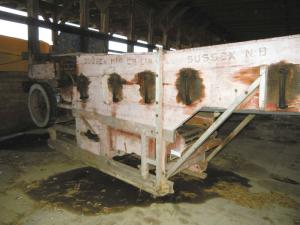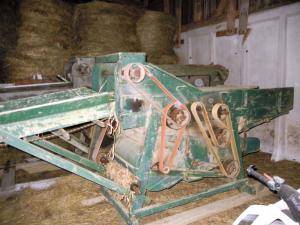He Uses Old Grain Threshers For Small Plots
Sean O’Donnell uses a Deere 3300 combine on his wheat fields, but when it comes to small fields and test plots, he turns to one of his stationary threshers. When dealing with only a few bushels of grain, it simply isn’t worth it to clean out the combine before and after. That's especially true when dealing with test plots.
“There are definitely situations where you’ve got too much grain for hand threshing, but not enough for a combine,” says O’Donnell. “Then an old stationary thresher is just right.”
O’Donnell is part of the rebirth in wheat production in Maine, once considered the breadbasket of the Northeast U.S. An organic farmer, he and several others are working with new wheat varieties that show promise for organic farmers.
“A couple of the varieties I’ve been working with look good for organic production, where we can’t use conventional fertilizer and pesticides,” says O’Donnell.
He picked up a Sussex Little Giant threshing machine at an auction. The thresher is only 3 ft. by 16 ft. and about 5 ft. tall. It was a junior version of larger threshers used on larger farms. He figures it'll be ideal as he grows out select varieties.
“Nobody seemed to know what it was, and I got it for only $100,” recalls O’Donnell. “I’ve been playing with it since. Last year I used it on some Red Fife (heritage variety) wheat, and it worked well.”
O’Donnell likes that most parts are wooden because he can fashion needed replacements in his wood shop. He notes that the wooden bolts and joints have dried out over the years in storage.
“It wobbles, so I plan to build a steel frame to give it more stability,” says O’Donnell. “Some of the threshing spikes were gone, but I can buy after-market spikes for older combine cylinders and make them work.”
In addition to wheat, O’Donnell raises edible soybeans and dry beans, including four heirloom dry bean varieties. He sells to market and produces seed for other growers.
“You have to be gentle with many heirloom varieties,” says O’Donnell.
He explains that a combine concave spins at 700 to 900 rpm’s while a stationary grain thresher concave will spin at 400 to 500. A dedicated bean thresher spins at only 150 to 200 rpm’s. On his larger fields of beans, he uses a Bidwell Bean Thresher, an early pull-type combine with a pick-up head. He finds an American #2 stationary thresher is fine for smaller fields and plots.
“They were commonly used for up to 5 acres of beans,” says O’Donnell. “I threshed out black beans with it last year and got 150 lbs. in roughly 2 hours. I just stuck the bean plants in the front and lugged the chaff away.”
Although the no. 2, like the Sussex, was originally belt-powered, O’Donnell adapted it for use with a pto. He notes that the early threshers were all designed to use flat drive belts.
“If I were to use them a lot, I would probably convert them to V-belts,” he says. “Flat belts are still easy to find at auctions, and you can get them new, but they can be a pain when they slide off.”
Contact: FARM SHOW Followup, Sean O’Donnell, 60 Cates Rd., Parkman, Maine 04443 (ph 207-270-8355; rustedroosterfarm@gmail.com).

Click here to download page story appeared in.
Click here to read entire issue
He Uses Old Grain Threshers For Small Plots COMBINES Miscellaneous Sean O’Donnell uses a Deere 3300 combine on his wheat fields but when it comes to small fields and test plots he turns to one of his stationary threshers When dealing with only a few bushels of grain it simply isn’t worth it to clean out the combine before and after That s especially true when dealing with test plots “There are definitely situations where you’ve got too much grain for hand threshing but not enough for a combine ” says O’Donnell “Then an old stationary thresher is just right ” O’Donnell is part of the rebirth in wheat production in Maine once considered the breadbasket of the Northeast U S An organic farmer he and several others are working with new wheat varieties that show promise for organic farmers “A couple of the varieties I’ve been working with look good for organic production where we can’t use conventional fertilizer and pesticides ” says O’Donnell He picked up a Sussex Little Giant threshing machine at an auction The thresher is only 3 ft by 16 ft and about 5 ft tall It was a junior version of larger threshers used on larger farms He figures it ll be ideal as he grows out select varieties “Nobody seemed to know what it was and I got it for only $100 ” recalls O’Donnell “I’ve been playing with it since Last year I used it on some Red Fife heritage variety wheat and it worked well ” O’Donnell likes that most parts are wooden because he can fashion needed replacements in his wood shop He notes that the wooden bolts and joints have dried out over the years in storage “It wobbles so I plan to build a steel frame to give it more stability ” says O’Donnell “Some of the threshing spikes were gone but I can buy after-market spikes for older combine cylinders and make them work ” In addition to wheat O’Donnell raises edible soybeans and dry beans including four heirloom dry bean varieties He sells to market and produces seed for other growers “You have to be gentle with many heirloom varieties ” says O’Donnell He explains that a combine concave spins at 700 to 900 rpm’s while a stationary grain thresher concave will spin at 400 to 500 A dedicated bean thresher spins at only 150 to 200 rpm’s On his larger fields of beans he uses a Bidwell Bean Thresher an early pull-type combine with a pick-up head He finds an American #2 stationary thresher is fine for smaller fields and plots “They were commonly used for up to 5 acres of beans ” says O’Donnell “I threshed out black beans with it last year and got 150 lbs in roughly 2 hours I just stuck the bean plants in the front and lugged the chaff away ” Although the no 2 like the Sussex was originally belt-powered O’Donnell adapted it for use with a pto He notes that the early threshers were all designed to use flat drive belts “If I were to use them a lot I would probably convert them to V-belts ” he says “Flat belts are still easy to find at auctions and you can get them new but they can be a pain when they slide off ” Contact: FARM SHOW Followup Sean O’Donnell 60 Cates Rd Parkman Maine 04443 ph 207-270-8355; rustedroosterfarm@gmail com
To read the rest of this story, download this issue below or click
here to register with your account number.








